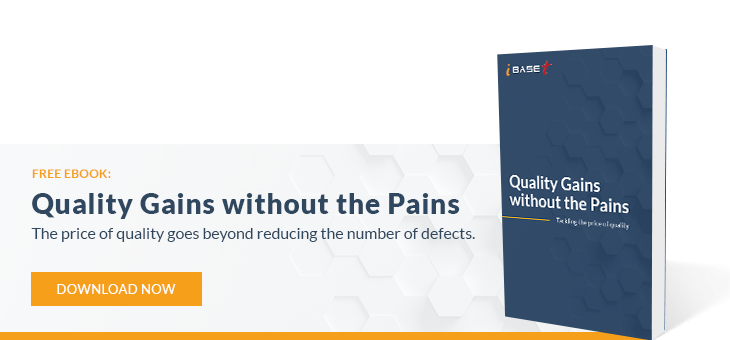
Because of the continuing coronavirus pandemic, 2022 will push Enterprise Quality Management Systems (EQMS) to become more integral to operations as companies face an ever more competitive and challenging production environment. Consequently, look to see a greater focus on how to embed quality management, automate its functions, and move it faster to the cloud as Enterprise QMS in 2022 becomes more critical to achieving operational excellence.
Standalone quality solutions are increasingly failing to meet the needs of organizations – and a lack of separate products is only reinforcing this trend. Expect existing suppliers to look for new partnerships and expand their offerings. Operationally focused providers should increase quality functionalities within their suites.
With increasing emphasis placed on sustainability, traceability, and the supply chain – coupled with the labor challenges facing the manufacturing industry – EQMS continues to increase its relevance to executive management. Many enterprises are shifting production back onshore. This shift is putting pressure to integrate quality across the value chain. In 2022, look for several key shifts in the quality management systems market. Here are three top predictions.
1. QMS Finally Catches Up with the Hype of Quality is Everyone’s Job
For more than a decade quality groups have proclaimed that “quality is everyone’s job” or that famous slogan from the Ford Motor Company back in the 1980s that “Quality is Job One”. For a little nostalgia, try watching this advertisement from 1983.
The idea that a small group off to the side was going to ensure quality by measuring a sample of output fell by the wayside more than a decade ago. Most business leaders got the message that quality must be built-in, it can’t be inspected. The problem was that the majority of quality applications still focused on capturing quality performance.
A key revelation was the recognition that once a quality issue was identified and corrected, a preventative plan was needed to keep the problem from reoccurring. But these corrective action/preventative action (CAPA) extensions tended to focus on internal operations and did not extend across the value chain. This myopic thinking was because the QMS solutions were still owned and operated by the internal quality function.
As MES and PLM vendors recognized that operational and engineering execution was the best place to drive quality performance, their product’s functionality expanded to encapsulate all the quality needs of manufacturing. Now the concept of quality is an integral part of everyone’s day-to-day activities is baked into select MES and other operational platforms. EQMS vendors are responding by either matching that functional footprint or at least forming strategic partnerships with other operations (OT) solution providers to deliver an integrated quality solution that everyone from the shop floor to the management team relies on.
2. Enterprise QMS in 2022 Is Moving to the Cloud
As enterprises opt to build agility and resilience into their operations, QMS, like most other operational applications, now must be Cloud-based. The advantages of MES On-Premises vs Cloud deployment are well documented. So too is the case with EQMS functionality, which is especially well suited for the Cloud for a few reasons:
-
- Quality is Iterative – The best quality programs focus on continuous improvement. In a cloud QMS deployment, it is much easier to scale up your use both across the enterprise (horizontally) as well as through increased functionality (vertically). With a cloud deployment, the ability to systematically cultivate quality is much easier.
- Quality is Multi-enterprise – Quality only works if it is implemented across the value chain. When it comes to quality, the GIGO expression comes to mind (garbage in = garbage out). Cloud-based QMS solutions, hosted on a global platform such as AWS or Azure, can provide for much better response times, localization, and support, leading to higher acceptance and utilization.
- Quality Demands can Change in an Instant – Covid has brought home the message that external factors can change the world of business in an instant. A previously reliable supplier can become inaccessible overnight due to regional lockdowns. This unplanned change will necessitate shifting to a different supplier, perhaps in another geography, where different standards and regulations may prevail. With a Cloud-based QMS, providers can quickly roll out new capabilities since all modern Cloud solutions are cloud-native and built using a microservices architecture.
Enterprise QMS in 2022 – It is the Year of Quality (Again)
As with most technologies, there is always someone willing to declare that this is “The Year of XYZ”. Whether it is MES, IoT, AI, or sustainability, there is always someone in the media ready to pronounce that the next year will be the breakthrough year for XYZ. In the past, there have been many declarations that the upcoming year was to be “The Year of Quality”. Well, my prediction is that in 2022 quality will see the kind of management attention and spending that would otherwise define it as such a year.
Regardless of the level of attention this prediction garners going forward, one thing we can count on is that quality will remain a key priority for management and that the market will react accordingly. Operational technology vendors in the MES and related spaces will continue to add considerable quality functionality to their products and QMS vendors will add operational extensions, either directly or via partnerships, to meet demand.
The challenge for many end-users will be to sort through the options to find the solution that best works for them. In that respect, for users, 2022 will mean taking a hard look at how they deploy and manage quality functionality.

